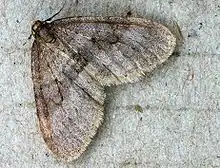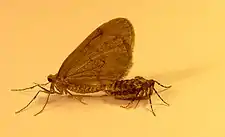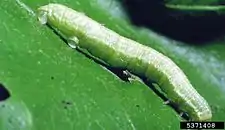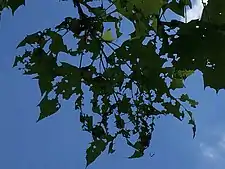Winter moth
The winter moth (Operophtera brumata) is a moth of the family Geometridae. It is an abundant species of Europe and the Near East and a famous study organism for evaluating insect population dynamics.[3] It is one of very few lepidopterans of temperate regions in which adults are active in late fall and early winter. The adults use endothermy for movement in these cold temperatures.[4] The female of this species is virtually wingless and cannot fly, but the male is fully winged and flies strongly. After the initial frosts of late fall, the females emerge from their pupa, walk to and up trees, there emitting pheromones in the evening to attract males. Fertilized, she ascends to lay, on average, around 100 eggs. Typically, the larger the female moth is the more eggs she lays.
- In North America, "winter moth" usually denotes the invasive species Operophtera brumata, but may also mean refer to a native species, Erannis tiliaria (linden looper) or Operophtera bruceata (bruce spanworm).
| Winter moth | |
|---|---|
 | |
| Scientific classification | |
| Kingdom: | Animalia |
| Phylum: | Arthropoda |
| Class: | Insecta |
| Order: | Lepidoptera |
| Family: | Geometridae |
| Genus: | Operophtera |
| Species: | O. brumata |
| Binomial name | |
| Operophtera brumata | |
| Synonyms | |
|
Cheimatobia brumata L.[1] | |
Winter moths are considered an invasive species in North America. Nova Scotia, Canada, experienced the first confirmed infestations in the 1930s. It was later accidentally introduced to Oregon in the 1950s and the Vancouver area of British Columbia around 1970. Defoliation by the moth was first noted in eastern states of the United States in the late 1990s, and is now well established in Massachusetts, Rhode Island, New Hampshire and Maine. Winter moth is confirmed present in British Columbia, Washington and Oregon.[5] In Massachusetts, the moths have attracted the attention of several media outlets due to the severity of the infestation.[6] Efforts at biological control are underway.[7][8]
Description

The forewing ground colour of the winged males varies from grey-yellow to beige-brown or occasionally slightly reddish-tinted. The patterns are often band-shaped dark brownish, often indistinct. The fringe is yellowish. The hindwings are pale grey or yellow grey. The antennae are short and finely hairy. The flightless female has a brownish-grey body with rudimentary wing stubs that are brown to grey and have dark bands. Body length for both sexes approximately 1.0 centimeters.[9] Larvae at hatching are 1/10 inch (2.5 mm) in length and will grow to 3/4 inch (20 mm) over a six-week period.[10] In North America, winter moth can be confused with the related native species Bruce spanworm (Operophtera bruceata). In fact, the two species hybridize.[11]
Distribution
Native to Northern and Central Europe: In the South, its range extends to Northern Italy; in the East to the Caucasus and Asia Minor; in the North to the Baltic. The genetic populations of winter moth in Europe are a result of recolonization following the last glacial period.[12] As an invasive species, this moth is found in Nova Scotia, coastal New England (Massachusetts, Maine, Rhode Island, Connecticut, and New York) and also the Pacific northwest (mainly Vancouver Island). In New England, expansion inland and north appears to be curtailed by cold winter temperatures, so for example, coastal Maine but not inland. Locally milder winters, as part of global climate change, may be allowing expansion of afflicted territory.[8][13] A study conducted in Massachusetts documented that winter moth defoliation reduced the annual trunk diameter growth rate of oak trees by an average of 47% while not significantly impacting growth rates of the less defoliated maple trees.[14]
Life cycle

Winter moth larvae (caterpillars) emerge in early spring from egg masses laid near leaf buds after a series of days in which the daytime high temperatures reach into the 50s Fahrenheit.[9] Research conducted in the Netherlands indicated that as climate warming is causing spring temperatures to become warmer sooner, some of the winter moth eggs were hatching before tree leaf buds - first food for the caterpillars - had begun to open. Early hatchlings starved. Late hatchlings survived. Because hatch timing is genetically controlled, the moths are evolving to resynchronize with bud opening by delaying the response to the temperature trigger by 5 to 10 days.[13] The larvae, like the adults, can withstand below freezing temperatures at night. Larval dispersal is the dominant source of density-dependent larval mortality and likely regulates high density population dynamics of winter moth in New England.[15] Larvae prefer Oak and Apple, but also feed on Maple, Birch, Hornbeam, Chestnut, Hazel, Quince, Beech, Larch, Poplar, Cherry, Pear, Rose, Raspberry, Blueberry, Willow, Elm, and other leafy trees and shrubs.[9][10]
Recently hatched larvae feed on expanding leaf buds, often after having burrowed inside the bud, and later on foliage, for approximately six weeks. In addition to feeding on the tree where they hatched, young larvae will also product silk strands to 'balloon' (be wind-blown) to other trees.[10] Defoliation can approach 90%. By mid-May the larvae, green in color and about an inch long, descend to the ground. Very little mortality due to disease has been noted in winter moth larvae in North America.[16][17] Pupation occurs in the soil in late May. Adults emerge from the soil in late fall to early winter, when, upon mating, the flightless female lays eggs in bark crevices and on branches.[14] With such a long pupal period, winter moth is vulnerable to numerous pupal predators and parasitoids.[18][19]
Biological control

In Europe, where winter moths are native, two parasitic species, a wasp (Agrypon flaveolatum) and a fly (Cyzenis albicans) prey on winter moth caterpillars. The wasps insert eggs into the larvae. The flies lay eggs on leaves, which the larvae ingest when eating the leaves.[20] As a biological control, the wasp was introduced in Canada but is not being pursued in the United States because there is not sufficient evidence that the wasp would not lay eggs in larvae of other moth species.[8] Introduction of C. albicans, which is species-specific to preying on winter moths, has proven successful in strongly reducing, although not entirely eliminating, winter moth infestation in Nova Scotia, Canada. Test introductions were begun in eastern Massachusetts in 2005. This proved successful, so more fly releases have taken place at sites from southeast Connecticut to coastal Maine. As moth densities can reach ten million larvae per acre, several years are needed before parasitism by the flies reaches 20-50%. Once this is achieved the winter moth density declines and leaf defoliation is reduced to levels not as harmful to the trees.[8] The delay in establishment is likely the result of heavy mortality from predators and hyperparasitoids on the pupating C. albicans.[21] Management of winter moth in Massachusetts using biological control with C. albicans is showing positive results.[22]
References
- "Operophtera brumata (winter moth)". CABI Invasive species compendium. Retrieved 2019-07-23.
- "Chimatobia". Nomenclator Zoologicus. Retrieved 2019-07-23.
- Futuyma, D.J. (2013). Annual Review of Ecology, Evolution, and Systematics.
- Heinrich, Bernd (1987). "Thermoregulation by winter-flying endothermic moths". J. Exp. Biol. 127 (`): 313–332.
- Cairn, North (8 December 2012). "Experts: Destructive winter moths are spreading". Portland Press Herald. Portland, Maine. Retrieved 9 December 2012.
- Noonan, Erica (3 December 2009). "Mystery Pests". Boston Globe. Boston, Massachusetts. Retrieved 9 December 2012.
- Elkinton, Joseph; Boettner, George; Liebhold, Andrew; Gwiazdowski, Rodger. "Biology, Spread, and Biological Control of Winter Moth in the Eastern United States" (PDF). USDA Forest Service. Retrieved 29 December 2018.
- Winter Moth in Massachusetts: History and Biological Control University of Massachusetts Extension, The Center for Agriculture, Food and the Environment (2017). Accessed Dec 6, 2017.
- Winter Moth Identification & Management UMass Extension The Center for Agriculture, Food and the Environment (2017) Accessed December 7, 2017.
- The Relationship Between the Winter Moth (Operophtera brumata) and Its Host Plants O'Donnell KM. University of Maine (2015)
- Havill, N.P.; Elkinton, J.; Andersen, J.C.; Hagen, S.B.; Broadley, H.J.; Boettner, G.J.; Caccone, A. (2017). "Asymmetric hybridization between non-native winter moth, Operophtera brumata (Lepidoptera: Geometridae), and native Bruce spanworm (Operophtera bruceata], in the Northeastern United States, assessed with novel microsatellites and SNPs". Bulletin of Entomological Research. 107 (2): 241–250. doi:10.1017/S0007485316000857. PMID 27876095.
- Andersen, Jeremy; Havill, Nathan; Caccone, Adalgisa; Elkinton, Joseph (2017). "Postglacial recolonization shaped the genetic diversity of the winter moth (Operophtera brumata) in Europe". Ecology and Evolution. 7 (10): 3312–3323. doi:10.1002/ece3.2860. PMC 5433974. PMID 28515868.
- Winter Moth Proves Able To Adjust To Climate Change. Netherlands Institute of Ecology (2007).
- Simmons MJ, Lee TD, Ducey MJ, Elkinton JS, Boettner GH, Dodds KJ (2014). "Effects of Invasive Winter Moth Defoliation on Tree Radial Growth in Eastern Massachusetts, USA". Insects. 5 (2): 301–18. doi:10.3390/insects5020301. PMC 4592589. PMID 26462685.
- Pepi, Adam; Broadley, Hannah; Elkinton, Joseph (2016). "Density‑dependent effects of larval dispersal mediated by host plant quality on populations of an invasive insect". Oecologia. 182 (2): 499–509. Bibcode:2016Oecol.182..499P. doi:10.1007/s00442-016-3689-z. PMID 27378097. S2CID 24424176.
- Broadley, H.J.; Boucher, M.; Burand, J.P.; Elkinton, J.S. (2017). "The phylogenetic relationship and cross-infection of nucleopolyhedroviruses between the invasive winter moth (Operophtera brumata) and its native congener, Bruce spanworm (O. bruceata)". Journal of Invertebrate Pathology. 142: 61–68. doi:10.1016/j.jip.2016.11.016. PMID 27916614.
- Donahue, K.L.; Broadley, H.J.; Elkinton, J.S.; Burand, J.P.; Huang, W.F.; Andersen, J.C. (2018). "Using the SSU, ITS, and Ribosomal DNA Operon Arrangement to Characterize Two Microsporidia Infecting Bruce spanworm, Operophtera bruceata (Lepidoptera: Geometridae)". Journal of Eukaryotic Microbiology. 66 (3): 424–434. doi:10.1111/jeu.12685. PMID 30136341.
- Roland, J.; Embree, D.G. (1995). "Biological control of the winter moth". Annual Review of Entomology. 40: 475–492. doi:10.1146/annurev.en.40.010195.002355.
- Broadley, Hannah (January 2018). "Impact of native natural enemies on populations of the invasive winter moth, (Operophtera brumata L) in the northeast United States". Doctoral Dissertations. Retrieved 29 December 2018.
- Capinera, John L. (2008). Encyclopedia of Entomology. Springer Science & Business Media. p. 4278. ISBN 978-1-4020-6242-1.
- Broadley, H.J.; Kelly, E.A.; Elkinton, J.S.; Kula, R.R.; Boettner, G.G. (2018). "Identification and impact of hyperparasitoids and predators affecting Cyzenis albicans (Tachinidae), a recently introduced biological control agent of winter moth (Operophtera brumata L.) in the northeastern U.S.A.". Biological Control. 121: 99–108. doi:10.1016/j.biocontrol.2018.01.011.
- Elkinton, Joseph; Boettner, George; Broadley, Hannah; Reardon, Richard; Weeks, Ronald. "Biological Control of Winter Moth in Northeast North America" (PDF). USDA Forest Service. Retrieved 29 December 2018.
Further reading
- Chinery, Michael, Collins Guide to the Insects of Britain and Western Europe, 1986 (Reprinted 1991)
- Skinner, Bernard, Colour Identification Guide to Moths of the British Isles, 1984
External links
| Wikimedia Commons has media related to Operophtera brumata. |
- UKmoths Winter Moth Operophtera brumata (Linnaeus, 1758)
- (in German) Lepiforum.de many excellent photos
